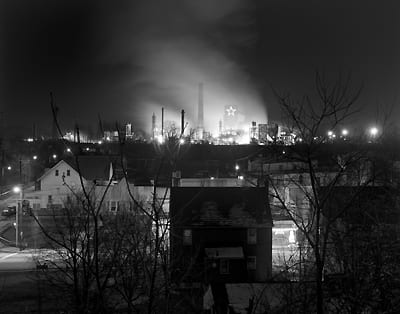
- This event has passed.
Joseph E.B. Elliott: Bethlehem Steel Portfolio

Excerpts from Elliott’s essay from a forthcoming book on his Bethlehem Steel photography:
The Bethlehem Steel photographs derive from my early interest in railroads and their associated landscapes: river courses, rail cuts and fills, bridges and viaducts, the industrial zones and specialized structures they were built to serve. Rail zones tend to occupy the older areas of the built environment and contain all shapes and sizes of commercial structures: warehouses, grain elevators, manufacturing complexes. The passage of time has brought periods of use, decay, and reuse, depositing artifacts from different eras. Until recently, these zones were seen as inhospitable to habitation by anyone other than the lowest strata of society, or off limits all together. I find them to be fascinating, containing architectural forms unknown to the public, and beautiful landscapes that are normally unseen. Rivers run below, nature reclaims abandoned sites: the results are new amalgamated ecologies.
We officially entered the plant in the summer of 1989, under the watchful eye of company metallurgist John Fielding, an old friend of Lance Metz.. John took us first to No.1 Forge Shop. Although its fourteen thousand ton press was long gone, the empty interior was magnificent. No. 1 Forge was one of many long shed-type buildings in the Lehigh Forge section of the plant, in various degrees of use and decay. This section of the plant had been constructed in the 1890s to produce battleship armor and cannon barrels to fit out the expanding fleet of the United States Navy. Built to house the age-old metal processes of melting, casting and forging, these spaces had a medieval feel to them. We made only one or two images that first day. I quickly learned that exposures would need to be exceedingly long to capture the exquisite structure and material quality of the vast dim spaces. Ten-minute exposures were not uncommon for us and allowed lots of time to ruminate and poke about. Distant sounds of steam escaping or trains rumbling past formed a background to our work. An employee for over twenty years, Fielding allowed that our process was about as exciting as watching paint dry.
As the official photographer on a Historic American Engineering Record project (HAER, an office of the U.S. Department of the Interior), I had to approach my work in a different manner than I had previously done in my New York waterfront ramblings. With my photographic work now framed as documentation rather than art, and with lots to do in relatively limited amounts of time, I usually concentrated on solving technical and logistical problems. When would the next furnace be tapped? What time would the 48-inch mill go back on line? Where could I set up the camera to get the best angle but not be crushed or burned? I worked with a 4×5 inch view camera that could only be used on a tripod. Exposures were very slow. Yielding superb detail and tonal subtlety, it was the best choice to deal with immense spaces and gigantic equipment. But my inability to shoot and move quickly meant that I often missed people and machinery that moved. The slow process also limited the number of views I could make. I would be forced to decide which few images would best describe what I was seeing.
The company announced that the blast furnaces would close in December 1995, marking the end of steel production. I visited the furnaces on the last two nights of operation. A handful of men were at work, and I walked in on my own from across the tracks. The operating blast furnace was relatively quiet. Almost like a breathing organism, the predominate sound was the rush of air through the stoves and tuyeres, and an occasional skip car dumping ore into the bell high on top of the furnace. I made exposures in the rain late at night.
The remaining part of the Bethlehem plant, the coke works, ran until 1997. Instead of feeding the Bethlehem furnaces, the coke was sold on the open market. Train loads were sent west to Rouge Steel in Detroit. I made my last image of the works looking across the hamlet of Didier, at midnight March 22, 1997, the last night of operation. Since then I have returned several times, but a dead steel mill is vastly different from a living one.











